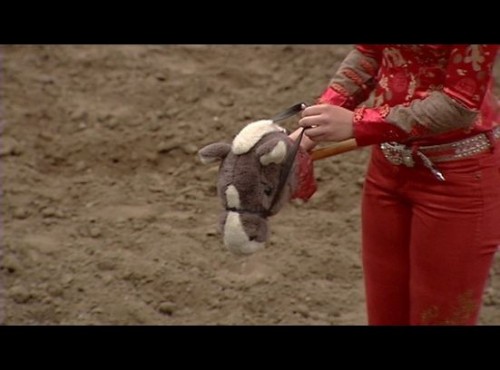Lindy hopper Jerry Almonte sent along a clip of the first place-winning routine in a division at the European Swing Dance Championships. Lindy hop is a partner dance invented by African American youth in Harlem dancing to swing music in the early 1930s. It’s near and dear to my heart; I’ve been a lindy hopper for 13 years (minus that year with a broken leg).
Modern day lindy hop raises difficult questions. In a post I wrote when the beloved Frankie Manning died, titled Race, Entertainment, and Historical Borrowing, I tried to capture the conundrum. I’m going to quote myself extensively, only because this is a tricky issue that deserves real discussion:
Though lindy hop was invented by African Americans, lindy hoppers today are primarily white. These contemporary dancers look to old movie clips of famous black dancers as inspiration. And this is where things get interesting: The old clips feature profoundly talented black dancers, but the context in which they are dancing is important. Professional black musicians, choreographers, and dancers had to make the same concessions that other black entertainers at the time made. That is, they were required to capitulate to white producers and directors who presented black people to white audiences. These movies portrayed black people in ways that white people were comfortable with: blacks were musical, entertaining, athletic (even animalistic), outrageous (even wild), not-so-smart, happy-go-lucky, etc.
So what we see in the old clips that contemporary lindy hoppers idolize is not a pure manifestation of lindy hop, but a manifestation of the dance infused by racism. While lindy hoppers today look at those old clips with nothing short of reverance, they are mostly naive to the fact that the dancing they are emulating was a product made to confirm white people’s beliefs about black people.
…
So we have a set of (mostly) white dancers who (mostly) naively and (always) wholeheartedly emulate a set of black dancers whose performances, now 70 to 80 years old, were produced for mostly white audiences and adjusted according to the racial ethos of the time. On the one hand, it’s neat that the dance is still alive; it’s wonderful to see it embodied, and with so much enthusiasm, so many years later. And certainly no ill will can be fairly attributed to today’s dancers. On the other hand, it’s troubling that the dance was appropriated then (for white audiences) and that it is that appropriation that lives on (for mostly white dancers). Then again, without those dancers, there would likely be no revival at all. And without those clips, however imperfect, the dance might have remained in obscurity, lost with the bodies of the original dancers.
It is this paradox that stirred Jerry to send along the clip of Dax Hock and Sarah Breck performing a routine that was an homage to a famous clip from the movie Day at the Races, featuring Whitey’s Lindy Hoppers. Here’s the original clip from 1937:
And here’s Dax and Sarah’s routine (Dax, btw, is in a fat suit; an entirely different and equally troublesome issue):
To be as clear as possible, I do believe 100% that Dax and Sarah have no intention to mock and, as essentially professional lindy hoppers, I doubt very much that they’ve never considered the ideas I’ve explained above.
Dax and Sarah are not my target here and, besides, they’re just two people. All conscious lindy hoppers struggle with these issues. My target, and my own personal struggle, is the entire endeavor.
I leave this as an open question for discussion, and one that extends far beyond lindy hop to jazz, blues, rap, and hip hop music; other forms of dance, like break dancing and pop and locking; and even the American obsession with spectating sports that are currently dominated by black athletes. It also extends far past the relationship between blacks and whites, as Adrienne Keene well illustrates in her blog, Native Appropriations.
How do white people, especially when they’re more or less on their racial own, honor art forms invented by oppressed racial groups without “stealing” them from those that invented them, misrepresenting them, or honoring them in ways that reproduce racism? You tell me… ’cause I’d like to know.
———————
For more, I’d be thrilled if you read my original post, inspired by the passing of Frankie Manning.
Also worth considering is this beautiful music video (Slow Club, Two Cousins) featuring lindy hoppers Ryan Francoise and Remy Kouakou Kouame performing vintage jazz movement. Is it different? What makes it so (other than production value and the race of the dancers)? Can you articulate it? Or is it tacit knowledge?
Inspired in part by The Spirit Moves?
Lisa Wade, PhD is an Associate Professor at Tulane University. She is the author of American Hookup, a book about college sexual culture; a textbook about gender; and a forthcoming introductory text: Terrible Magnificent Sociology. You can follow her on Twitter and Instagram.










